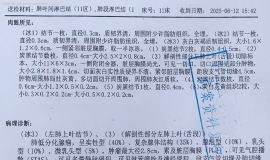и„‘йғЁж”ҫз–—пјҢдёҠеҚҲжҜ”дёӢеҚҲж•Ҹж„ҹи®ёеӨҡпјҒ
' w; I# A, G$ ? I0 t9 E- o1 T/ I, e; R9 Q7 I
9 e: g' O" u( }0 K% O' pCancer 2011 Jan 15;117(2):414-20. doi: 10.1002/cncr.25423. Epub 2010 Sep 9.
8 A1 O5 r- U0 G0 }, j3 O+ i' @Gamma knife radiosurgery for brain metastasis of nonsmall cell lung cancer: is there a difference in outcome between morning and afternoon treatment?& X6 j, `: Y4 G
Rahn DA 3rd, Ray DK, Schlesinger DJ, Steiner L, Sheehan JP, O'Quigley JM, Rich T.
; Y+ M1 B! @& m5 T8 K+ d1 ~SourceDepartment of Radiation Oncology, University of Virginia Health Sciences Center, Charlottesville, Virginia 22908, USA.& u" q! ]" c5 U+ v/ ?7 I
* z% J. ^0 R6 ]5 R
Abstract
$ Y0 X6 ?4 o. I; OBACKGROUND: Circadian cell-cycle progression causes fluctuating radiosensitivity in many tissues, which could affect clinical outcomes. The purpose of this study was to determine whether outcomes of single-session gamma knife radiosurgery (GKRS) for metastatic nonsmall cell lung cancer (NSCLC) differ based on treatment time.* d( V* a6 G" l
+ ~7 |) S& e) d% [) u* e; O% w4 H4 F: nMETHODS: Fifty-eight patients received GKRS between 10:00 am and 12:30 pm and 39 patients received GKRS between 12:30 pm and 3:00 pm. The mean peripheral dose was 18.6 Gy. The mean tumor size was 7.3 cm³. Magnetic resonance imaging was used to score local control at 3 months. Cause of death (COD) was categorized as central nervous system (CNS)-related or systemic.6 G( |; u( B5 v7 @/ N: W( \
* l0 @. f) |$ r3 {. q5 {RESULTS: Demographic and disease characteristics of the 2 groups were similar. Local control at 3 months was achieved in 97% (35/36) of patients who underwent GKRS early in the day versus 67% (8/12) of patients who underwent GKRS later in the day (chi-square, P = .014). Early GKRS was associated with better survival (median 9.5 months) than late GKRS (median 5 months) (Kaplan-Meier log-rank test, P = .025). Factors contributing to better survival in a Cox regression model included early treatment time (P = .004) and recursive partition analysis class (P < .001). Cause of death in the early treatment group was CNS-related in 6% (3/47) of patients versus 24% (8/34) of patients in the late treatment group (chi-square test, P = .026).
; u) b# E; H8 a! N( J
' L! A' r- _ ]: e3 Q, bCONCLUSIONS: GKRS for metastatic NSCLC had better local control, better survival, and a lower rate of CNS-related cause of death when given earlier in the day versus later in the day. These retrospective data should encourage future study in brain radiosurgery and non-CNS stereotactic body radiotherapy series.& t$ c; q5 [+ \3 p/ s2 p n
, k3 H# |8 H+ ?- t6 N
|


